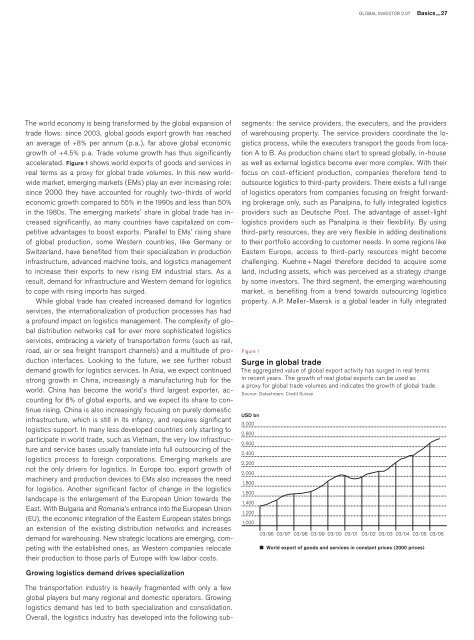You also want an ePaper? Increase the reach of your titles
YUMPU automatically turns print PDFs into web optimized ePapers that Google loves.
GLOBAL INVESTOR 2.07 Basics — 27<br />
The world economy is being transformed by the <strong>global</strong> expansion of<br />
trade flows: since 2003, <strong>global</strong> goods export growth has reached<br />
an average of +8% per annum (p.a.), far above <strong>global</strong> economic<br />
growth of +4.5% p.a. Trade volume growth has thus significantly<br />
accelerated. Figure 1 shows world exports of goods and services in<br />
real terms as a proxy for <strong>global</strong> trade volumes. In this new worldwide<br />
market, emerging markets (EMs) play an ever increasing role:<br />
since 2000 they have accounted for roughly two-thirds of world<br />
economic growth compared to 55% in the 1990s and less than 50%<br />
in the 1980s. The emerging markets’ share in <strong>global</strong> trade has increased<br />
significantly, as many countries have capitalized on competitive<br />
advantages to boost exports. Parallel to EMs’ rising share<br />
of <strong>global</strong> production, some Western countries, like Germany or<br />
Switzerland, have benefited from their specialization in production<br />
infrastructure, advanced machine tools, and logistics management<br />
to increase their exports to new rising EM industrial stars. As a<br />
result, demand for infrastructure and Western demand for logistics<br />
to cope with rising imports has surged.<br />
While <strong>global</strong> trade has created increased demand for logistics<br />
services, the internationalization of production processes has had<br />
a profound impact on logistics management. The complexity of <strong>global</strong><br />
distribution networks call for ever more sophisticated logistics<br />
services, embracing a variety of transportation forms (such as rail,<br />
road, air or sea freight transport channels) and a multitude of production<br />
interfaces. Looking to the future, we see further robust<br />
demand growth for logistics services. In Asia, we expect continued<br />
strong growth in China, increasingly a manufacturing hub for the<br />
world. China has become the world’s third largest exporter, accounting<br />
for 8% of <strong>global</strong> exports, and we expect its share to continue<br />
rising. China is also increasingly focusing on purely domestic<br />
infrastructure, which is still in its infancy, and requires significant<br />
logistics support. In many less developed countries only starting to<br />
participate in world trade, such as Vietnam, the very low infrastructure<br />
and service bases usually translate into full outsourcing of the<br />
logistics process to foreign corporations. Emerging markets are<br />
not the only drivers for logistics. In Europe too, export growth of<br />
machinery and production devices to EMs also increases the need<br />
for logistics. Another significant factor of change in the logistics<br />
landscape is the enlargement of the European Union towards the<br />
East. With Bulgaria and Romania’s entrance into the European Unio n<br />
(EU), the economic integration of the Eastern European states brings<br />
an extension of the existing distribution networks and increases<br />
demand for warehousing. New strategic locations are emerging, competing<br />
with the established ones, as Western companies relocate<br />
their production to those parts of Europe with low labor costs.<br />
segments: the service providers, the executers, and the providers<br />
of warehousing property. The service providers coordinate the logistics<br />
process, while the executers transport the goods from location<br />
A to B. As production chains start to spread <strong>global</strong>ly, in-house<br />
as well as external logistics become ever more complex. With their<br />
focus on cost-efficient production, companies therefore tend to<br />
outsource logistics to third-party providers. There exists a full range<br />
of logistics operators from companies focusing on freight forwarding<br />
brokerage only, such as Panalpina, to fully integrated logistics<br />
providers such as Deutsche Post. The advantage of asset-light<br />
logis tics providers such as Panalpina is their flexibility. By using<br />
third-party resources, they are very flexible in adding destinations<br />
to their portfolio according to customer needs. In some regions like<br />
Eastern Europe, access to third-party resources might become<br />
challenging. Kuehne + Nagel therefore decided to acquire some<br />
land, including assets, which was perceived as a strategy change<br />
by some investors. The third segment, the emerging warehousing<br />
market, is benefiting from a trend towards outsourcing logistics<br />
property. A.P. Møller-Maersk is a <strong>global</strong> leader in fully integrated<br />
Figure 1<br />
Surge in <strong>global</strong> trade<br />
The aggregated <strong>value</strong> of <strong>global</strong> export activity has surged in real terms<br />
in recent years. The growth of real <strong>global</strong> exports can be used as<br />
a proxy for <strong>global</strong> trade volumes and indicates the growth of <strong>global</strong> trade.<br />
Source: Datastream, Credit Suisse<br />
USD bn<br />
3,000<br />
2,800<br />
2,600<br />
2,400<br />
2,200<br />
2,000<br />
1,800<br />
1,600<br />
1,400<br />
1,200<br />
1,000<br />
03/96 03/97 03/98 03/99 03/00 03/01 03/02 03/03 03/04 03/05 03/06<br />
World export of goods and services in constant prices (2000 prices)<br />
Growing logistics demand drives specialization<br />
The transportation industry is heavily fragmented with only a few<br />
<strong>global</strong> players but many regional and domestic operators. Growing<br />
logistics demand has led to both specialization and consolidation.<br />
Overall, the logistics industry has developed into the following sub-

















